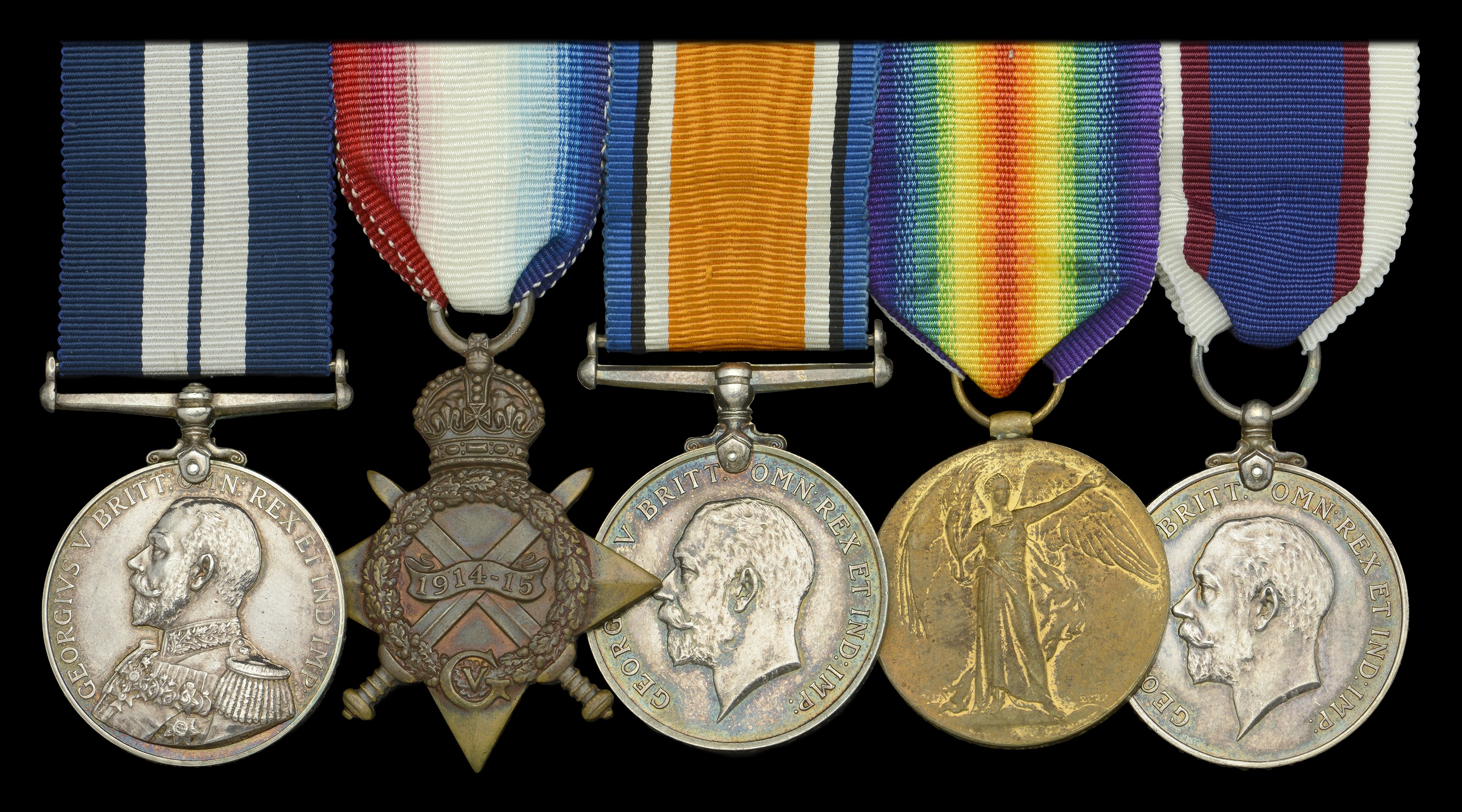The Great War Q-Ship operations D.S.M. group of five awarded to Able Seaman D. Pearce, who was decorated for his gallantry at the helm of ‘the splendid Penshurst’ in August 1917 Distinguished Service Medal, G.V.R. (S.S.6073. D. Pearce, A.B. Atlantic Ocean. 19 Aug. 1917.) small erasure after rate; 1914-15 Star (SS.6073, D. Pearce, Ord., R.N.); British War and Victory Medals (S.S.6073 D. Pearce. A.B. R.N.); Royal Fleet Reserve L.S. & G.C, G.V.R., 2nd issue (SS.6073 (Dev. B., 11016) D. Pearce. A.B. R.F.R.) mounted as worn, nearly extremely fine (5) £1,400-£1,800 --- Importation Duty This lot is subject to importation duty of 5% on the hammer price unless exported outside the UK --- --- D.S.M. London Gazette 2 November 1917: ‘The following awards have been approved.’ The original (joint) recommendation states: ‘H.M.S. Penshurst (Q7). Attack on German submarine. 19 August 1917. These three ratings [A.B. Donald Pearce, Seaman Michael Murphy and A.B. Edward Bunting] acted as Quartermaster. Murphy was at the wheel when the torpedo struck and was violently thrown across the bridge, but on seeing that the steering gear on the bridge was damaged, at once proceeded to the hand steering gear aft and carried on. All three subsequently did splendid work in steering the ship under the most disadvantageous conditions, the wheel being situated at the top of the engine room amongst steam and much heat from the engines.’ Donald Pearce was born in Southall, London on 3 May 1896 and entered the Royal Navy as an Ordinary Seaman in June 1915. Having then been borne on the books of H.M.S. Blake, he commenced his career in the clandestine world of Q-Ships on 16 February 1917, when he joined the ship’s company of Q.7 - also known as Penshurst - under the command of Commander F. H. Grenfell, D.S.O., R.N. Described by naval historian Keble Chatterton as ‘a courteous and charming country gentleman whose shy manner concealed an exceptionally gallant spirit,’ Grenfell and his newly enlisted rating would quickly see action, initially in an inconclusive affair against the UC-66 on the 20th. Events on the 22nd proved to be of a more certain nature, when Penshurst engaged the U-84 off the south coast of Ireland. Having avoided a torpedo attack, Grenfell and his men achieved several hits, causing U-84 significant damage and wounding members of her crew. The U-boat managed to limp back to Germany on the surface, where Admiral Scheer described her survival as a miracle. Grenfell was specially promoted to Captain and he was back in action on 8 March when the Penshurst fought another surface action, this time with the UC-44 at the Eastern end of the English Channel. Both vessels were badly damaged, Penshurst requiring a major refit. It was at this juncture that Grenfell was appointed to the Staff of the Director of Anti-Submarine Defence and command of the Penshurst fell to his senior officer, Lieutenant Cedric Naylor, D.S.C., R.N.R. He fought his first action as captain on 2 July, in the Western Approaches, his gunners getting in 16 hits on the U-53 before the submarine fled the scene. But it was for Penshurst’s next action, fought on 19 August 1917, that Pearce was awarded the D.S.M. Badly damaged by a torpedo strike below her bridge, and with her hidden guns prematurely exposed, the Penshurst nonetheless pretended to ‘run away’ when the enemy submarine, the UC-72, surfaced. She then opened fire with her 3-pounder gun in an attempt to entice the submarine closer before opening up with her heavier guns. Penshurst also used her 12-pounder with good effect and hit UC-72 four times, causing her to break off the action and dive. Penshurst, in her damaged state, was unable to follow up with depth charges and so set course for Plymouth and much needed repairs. Pearce was subsequently present on the occasion of Penshurst’s loss in the Irish Sea on 24 December 1917, when she was torpedoed by the U-110. Owing to the Q-ship’s heavy list, her guns were limited in their capability to return fire, but she managed to get in two hits before slipping beneath the waves. Remarkably, in the circumstances, all but two of the ‘Splendid Penshurst’s’ crew were rescued. Pearce ended the war with an appointment in Europa I and was demobilised in June 1920. Sold with copied research including Naylor’s report following the loss of the Penshurst in December 1917.
Auctioneer's Buyers Premium: 24% (+VAT)
There is an additional charge of 4.95% (+VAT/sales tax)
Vollständige AGBs





